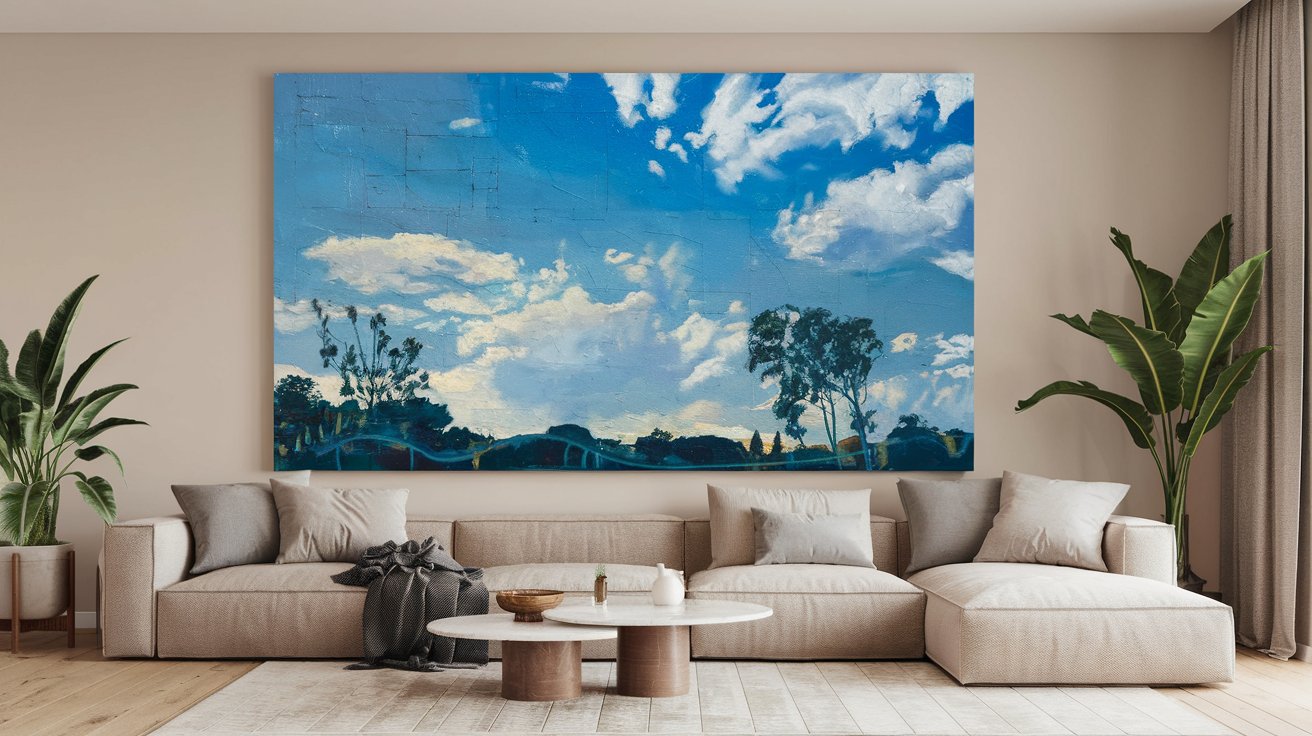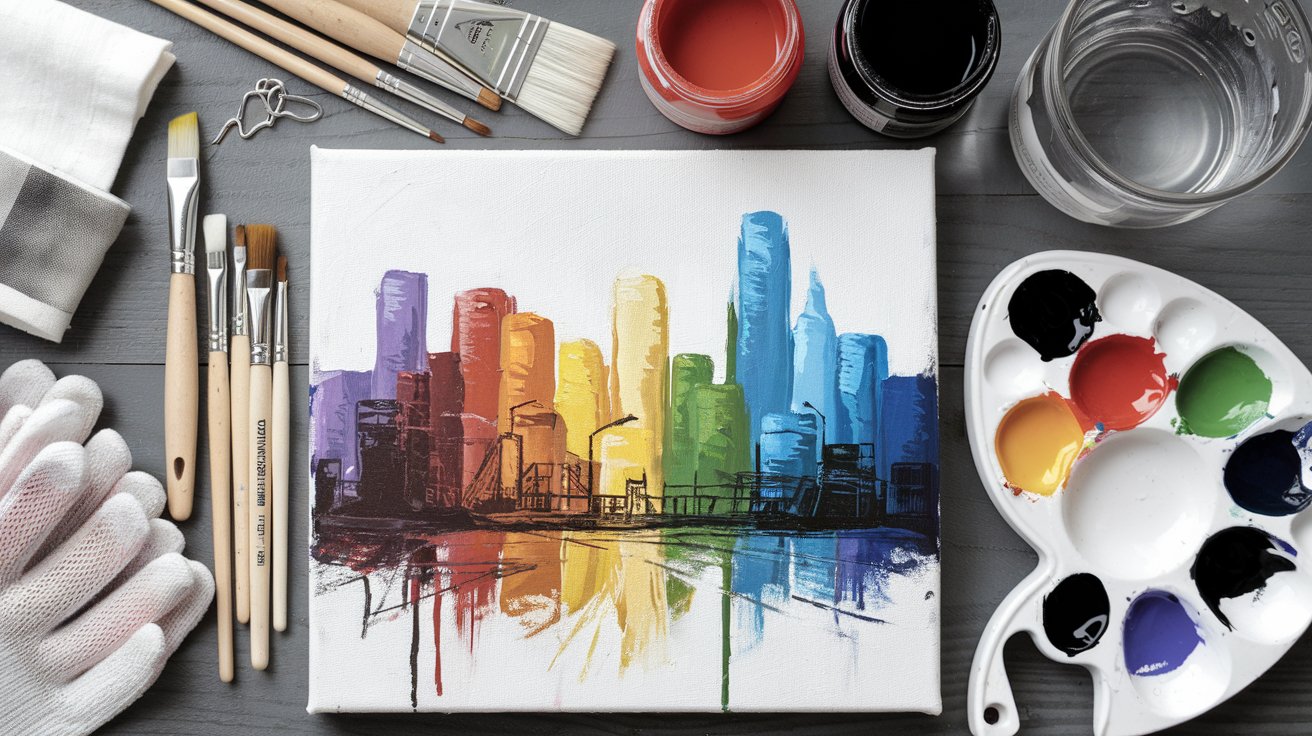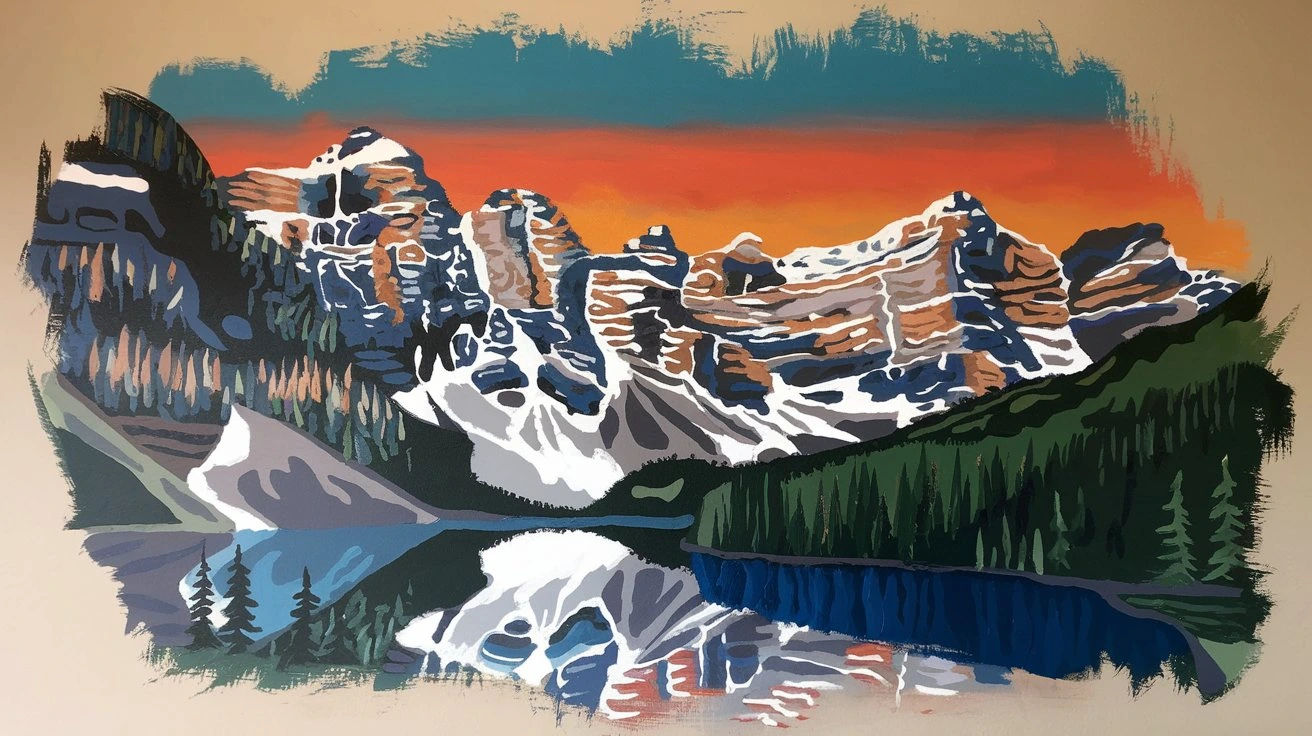Table of Contents
Acrylic painting wall Art is one of the most versatile and beginner-friendly mediums, offering artists the ability to create vibrant and durable works of art. Whether you’re new to painting or transitioning from another medium, acrylics provide an excellent platform to experiment, learn, and grow. This guide will introduce you to essential acrylic painting techniques that are perfect for beginners.

Why Choose Acrylic Paint?
Acrylic paints are water-based, making them easy to clean painting wall Art, fast-drying, and less toxic than oil paints painting wall Art. They can be used on a variety of surfaces, from canvas to wood to paper, and offer great flexibility in terms of opacity, texture, and color blending. Additionally, they dry quickly, which means you can apply multiple layers in a relatively short time.
Essential Materials for Acrylic Painting wall Art

Before diving into techniques, it’s important to gather the right materials. Here’s what you’ll need:
- Acrylic Paints: Start with a basic set of primary colors (red, blue, yellow) along with black and white. These can be mixed to create a wide range of hues.
- Brushes: Have a variety of brush sizes and shapes (flat, round, filbert) to explore different strokes and textures.
- Palette: A surface for mixing paints. A flat palette or disposable palette paper works well.
- Canvas or Paper: You can use stretched canvas, canvas boards, or acrylic paper.
- Palette Knife: Useful for mixing colors or applying paint in thick layers.
- Water and Containers: For rinsing brushes and thinning paints.
- Rags or Paper Towels: For wiping brushes and cleaning up spills.
- Acrylic Mediums: Optional, but can help with thinning, thickening, or adding texture to your paint.
1. Dry Brush Technique wall Art

The dry brush technique is when you apply paint with a relatively dry brush, meaning there is minimal water mixed in. This creates a scratchy, textured look on the surface and is great for creating highlights, painting wall Art, texture, or fine details.
- How to Do It: Dip the tip of your brush in paint and wipe off any excess on a rag. Gently drag the brush across the canvas, leaving behind streaks of color that create a textured effect. This technique works well for portraying hair, grass, or textured surfaces like wood.
2. Wet-on-Wet Blending
Wet-on-wet blending is a technique where you apply wet paint onto a surface that already has wet paint, allowing the colors to blend smoothly painting wall Art. This method is excellent for creating soft transitions, such as in skies or water.
- How to Do It: First, apply a layer of paint to your canvas. While it’s still wet, add another color to the canvas and blend the two colors using gentle brush strokes or a sponge. Keep the brush or sponge damp to ensure the colors blend smoothly. Practice blending from one color to another, such as from blue to white for a smooth gradient sky.
3. Scumbling
Scumbling is a technique where you layer dry or semi-dry paint over an existing layer painting wall Art. This creates a rough, broken effect that allows some of the underlying color to show through, adding depth and texture.
- How to Do It: Load your brush with a small amount of paint, and apply it in a loose, scrubbing motion across the surface. Use a light hand so that the paint doesn’t completely cover the surface. Scumbling works well for adding soft texture, such as in clouds or distant landscapes.
4. Glazing
Glazing involves applying a thin, transparent layer of paint over a dry layer of painting wall Art. This technique allows you to build up color gradually and create a sense of depth. It’s especially useful for adding shadows or adjusting the tone of an area without completely covering the original colors.
- How to Do It: Mix your acrylic paint with a glazing medium to thin it out and make it transparent. Apply the glaze in thin layers using a soft brush. Allow each layer to dry completely before applying the next. Glazing can be used to create luminous effects or deepen shadows without losing the underlying detail.
5. Impasto Technique
The impasto technique involves applying thick layers of paint to the canvas painting wall Art, creating texture that stands out from the surface. This method gives your artwork a three-dimensional quality and works best with a palette knife or a thick brush.
- How to Do It: Load your palette knife with paint and apply it to the canvas in thick, sweeping motions. You can create peaks and ridges that give the painting a tactile quality. The impasto technique is great for adding texture to landscapes or abstract art.
6. Sgraffito
Sgraffito is a technique where you scratch into the top layer of paint to reveal the color underneath painting wall Art. This can create interesting textures and intricate designs, making it perfect for adding fine details to your artwork.
- How to Do It: First, apply a base layer of paint and let it dry. Then, add a second layer of paint over it. While the second layer is still wet, use a palette knife, comb, or even the end of a brush to scrape away the top layer, revealing the color underneath. Sgraffito is often used to create textures like tree bark, hair, or intricate patterns.
7. Pouring Technique
The pouring technique is a popular acrylic painting method for creating abstract, fluid designs. This involves mixing acrylic paint with a pouring medium to achieve a runny consistency, allowing the paint to flow freely across the canvas.
- How to Do It: Mix acrylic paint with a pouring medium until it has a liquid consistency. Then, pour the paint directly onto the canvas and tilt it to spread the colors. You can pour multiple colors at once to create interesting swirls and abstract patterns. This technique is unpredictable and perfect for creating vibrant, organic designs.
8. Sponging
Sponging is a simple technique where you use a sponge to apply paint in a stippling or dabbing motion painting wall Art. This method can create interesting textures and soft transitions of color, making it perfect for backgrounds or natural textures like clouds and foliage.
- How to Do It: Dip a sponge into your paint and dab it onto the canvas. You can layer different colors to create depth and texture. Sponging is great for achieving soft, natural effects, like mist or ocean waves.
9. Stippling
Stippling is the process of creating tiny dots of paint on the canvas to build up an image painting wall Art. This technique can be time-consuming, but it creates a unique texture and is great for adding shading or fine detail to your painting.
- How to Do It: Use a small brush or even the tip of a pencil to dab small dots of paint onto the canvas. Keep the dots close together for darker areas and spread them out for lighter areas. Stippling is excellent for adding texture to grass, foliage, or skin in portraits.
10. Layering wall Art
Layering is the process of applying multiple layers of paint, each one building upon the previous layer. This technique allows you to create depth and dimension in your artwork.
- How to Do It: Begin with a base layer of paint and let it dry completely. Then, apply additional layers of paint, either to build up color or add details. Layering is useful for creating complex compositions with a lot of depth.
Final Tips for Beginners
- Experiment: Don’t be afraid to try different techniques and see what works best for you. Acrylics are forgiving, and you can easily paint over mistakes.
- Use Water Wisely: Acrylic paints dry quickly, so keep a spray bottle of water nearby to mist your palette and keep your paints moist.
- Work in Layers: Start with lighter colors and gradually build up to darker ones.
- Practice Patience: Some techniques, like glazing and layering, require drying time between steps. Be patient to achieve the best results.
Conclusion
Acrylic painting offers endless possibilities for beginners to explore. From dry brushing to glazing, each technique opens up new ways to express your creativity. With practice and experimentation, you’ll soon develop your own style and master these techniques, creating stunning works of art that are vibrant and full of depth.
Now that you’ve learned these essential acrylic painting techniques, it’s time to pick up your brush and start creating!
FAQs: How to Use Modeling Paste in Wall Art
1. What is modeling paste, and how is it used in wall art?
- Modeling paste is a thick, texturizing medium often used in art to create raised or 3D effects on surfaces like canvas, wood, or walls. It can be applied with a palette knife or brush to build layers and add depth and texture to painting wall art pieces.
2. Can modeling paste be mixed with paint?
- Yes, you can mix modeling paste with acrylic paint to add color directly to the paste before application. Alternatively, you can apply the paste first and then paint over it once it dries, allowing for more color flexibility.
3. How long does modeling paste take to dry?
- The drying time for modeling paste varies depending on the thickness of application and humidity levels. Generally, a thin layer can dry within a few hours, but thicker layers may take up to 24 hours or more to dry completely.
4. What surfaces work best for using modeling paste?
- Modeling paste adheres well to sturdy surfaces like canvas, wood, and primed walls. It’s essential to ensure the surface is clean and primed for better adhesion and durability.
5. Can I use modeling paste on an already painted wall?
- Yes, modeling paste can be applied to a painted wall. However, it’s best to ensure the wall is smooth and clean before application. For best results, consider priming the area where you intend to add the paste.
6. Is modeling paste waterproof or durable over time?
- Modeling paste is not inherently waterproof, but sealing it with a varnish or sealant after it dries can protect it from moisture and improve durability. In high-humidity areas, a moisture-resistant sealant is recommended.
7. Can modeling paste be sanded or carved after it dries?
- Yes, once modeling paste is fully dried, it can be sanded down to smooth rough areas or even carved for added detail. This allows for further customization of the texture and design.
8. What are some creative effects that can be achieved with modeling paste?
- Modeling paste can create various effects, from simple textured patterns to complex 3D forms. Artists use it to add dimension, create impasto effects, make stenciled patterns, or layer for a bas-relief look.
9. Is modeling paste safe to use indoors?
- Modeling paste is generally safe for indoor use, especially if water-based. However, using it in a well-ventilated area is recommended, especially if using an acrylic-based paste that may emit mild odors.
10. Can beginners use modeling paste easily?
- Yes! Modeling paste is easy to work with and can be an enjoyable medium for beginners. Start with simple applications and practice spreading and texturing techniques to get comfortable with the material.
Painting wall Art, Painting wall Art, Painting wall Art, Painting wall Art, Painting wall Art, Painting wall Art,Painting wall Art.
